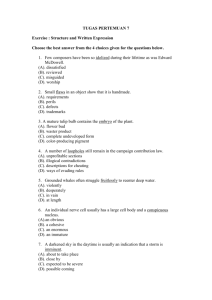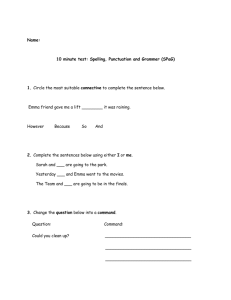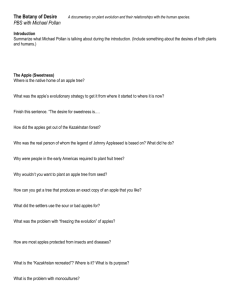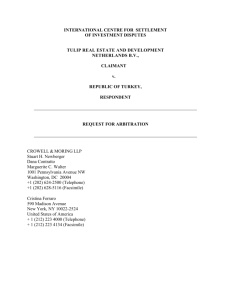Tulip Bulb Mania - Historyteacher.net
advertisement
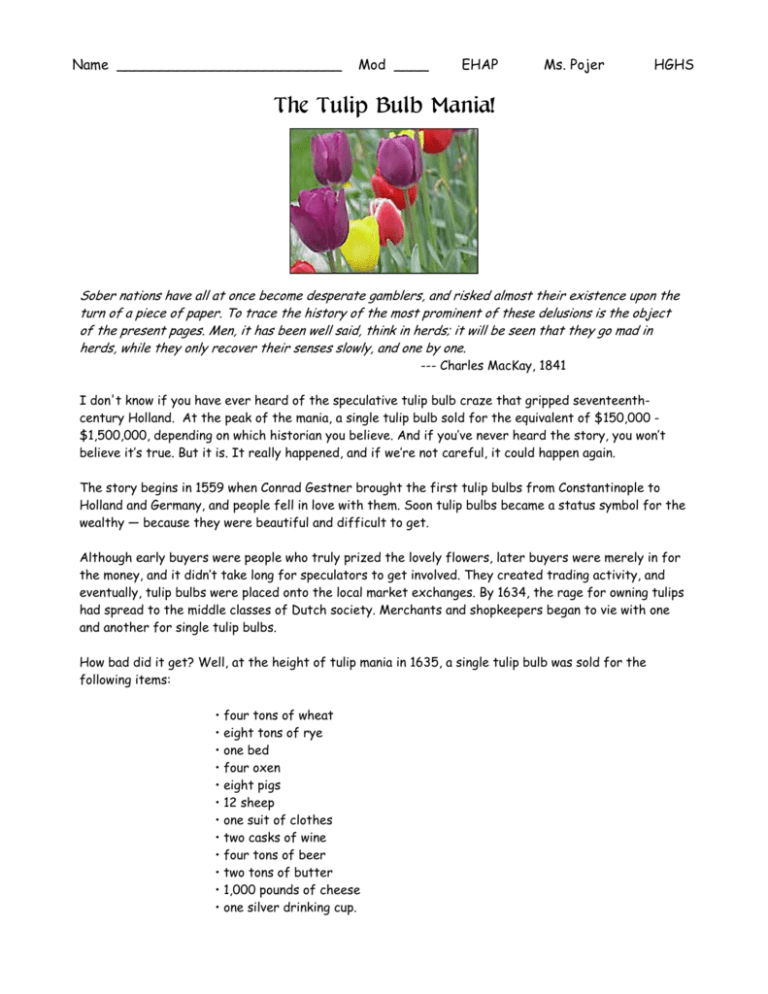
Name __________________________ Mod ____ EHAP Ms. Pojer HGHS The Tulip Bulb Mania! Sober nations have all at once become desperate gamblers, and risked almost their existence upon the turn of a piece of paper. To trace the history of the most prominent of these delusions is the object of the present pages. Men, it has been well said, think in herds; it will be seen that they go mad in herds, while they only recover their senses slowly, and one by one. --- Charles MacKay, 1841 I don't know if you have ever heard of the speculative tulip bulb craze that gripped seventeenthcentury Holland. At the peak of the mania, a single tulip bulb sold for the equivalent of $150,000 $1,500,000, depending on which historian you believe. And if you’ve never heard the story, you won’t believe it’s true. But it is. It really happened, and if we’re not careful, it could happen again. The story begins in 1559 when Conrad Gestner brought the first tulip bulbs from Constantinople to Holland and Germany, and people fell in love with them. Soon tulip bulbs became a status symbol for the wealthy — because they were beautiful and difficult to get. Although early buyers were people who truly prized the lovely flowers, later buyers were merely in for the money, and it didn’t take long for speculators to get involved. They created trading activity, and eventually, tulip bulbs were placed onto the local market exchanges. By 1634, the rage for owning tulips had spread to the middle classes of Dutch society. Merchants and shopkeepers began to vie with one and another for single tulip bulbs. How bad did it get? Well, at the height of tulip mania in 1635, a single tulip bulb was sold for the following items: • four tons of wheat • eight tons of rye • one bed • four oxen • eight pigs • 12 sheep • one suit of clothes • two casks of wine • four tons of beer • two tons of butter • 1,000 pounds of cheese • one silver drinking cup. The present day value of all these items? Nearly $35,000! Can you imagine spending $35,000 for a single tulip bulb? This was happening in Holland in the mid-17th century. It was getting so bizarre that people were selling everything they owned – their homes, their livestock, everything – for the privilege of owning tulips, on the expectation that the bulbs would continue to grow in value. As a result, prices – in today’s dollars – ranged from $17,000 all the way up to $76,000 for a single bulb. By 1636, tulips were established on the Amsterdam stock exchange. Popular interest had shifted from hobbyists and collectors to speculators and gamblers. People from all walks of life liquidated their homes and real estate at incredibly low prices in order to speculate in tulip trading. Tulip notaries and clerks were appointed to record transactions, and public laws and regulations were developed to control the tulip craze. But in 1636, some began to liquidate their tulip holdings. Tulip prices began to weaken, slowly at first, and then rapidly. Confidence was soon destroyed, and panic seized the market. Within six weeks, tulip prices crashed by 90%. Defaults on contracts and liens on owners were widespread. At first the Dutch government refused to interfere. Instead, it simply advised tulip holders to agree among themselves on some plan to stabilize prices and restore public confidence. These plans failed. Eventually, assembled deputies in Amsterdam declared null and void all contracts that were made at the height of the mania, meaning prior to November 1636. Tulip contracts made subsequent to that date were settled if buyers paid merely 10% of the prices to which they had earlier agreed. But tulip prices continued to fall. Next, the provincial council in the Hague was asked to invent some measure to stabilize tulip prices and public credit. Those efforts failed. Tulip prices again fell even lower. In Amsterdam, judges unanimously refused to honor tulip contracts, regarding them as gambling activities. The court rules that gambling debts were not debts in the eyes of the law. No court in Holland could — or would — enforce payment. Tulip collectors, speculators, and gamblers who had tulips at the time of the collapse were left to bear ruinous losses. Tulip prices soon plunged to less than the present equivalent of a dollar each. Imagine having bought a tulip for $76,000, only to discover six weeks later that it was now worth less than one dollar. Commerce in Holland suffered a severe shock, and did not recover for many years. Now I know what you are saying, “Come on! … who on earth could possibly have gotten caught up in that?” I know how you feel. After all, we’re talking tulips here – not food, shelter, clothing, or firearms for defense! We’re talking TULIPS! What practical value could tulips have had in Holland in 1636? And what could cause people to lose such control of their senses? SOURCE: Stock Market Crash History. “The Tulip Bulb Mania” at <http://www.stock-market-crash.net/tulip-mania.htm>

